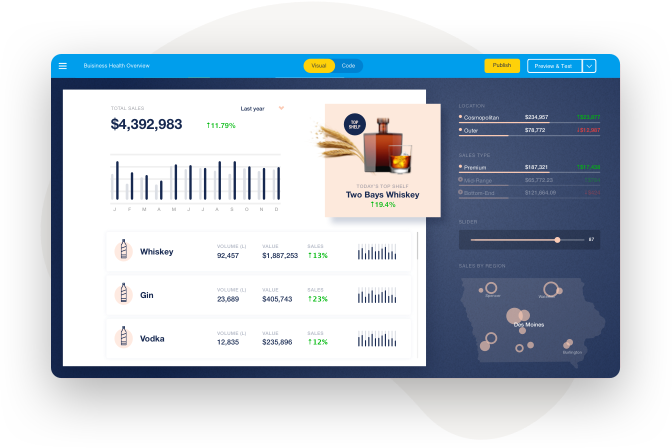
The death of the dashboard: What it really means for analytics
The data needs of modern BI users has evolved past what dashboards can provide, leading to a bold proclamation they are dead. The reality? The dashboard's role isn't over - but its decline is helping usher in a new wave of analytics solutions.
Let’s get this out of the way: To understand the much discussed ’death of the dashboard' proclamation, the phrase needs to be viewed under a different lens beyond the literal.
Firstly, it's not a new concept at all: Yellowfin have been saying it for years. The problem is in the current interpretation around what it actually means for business intelligence.
In short, dashboards aren’t actually dying, nor is their usefulness for certain users spent - the real meaning behind the phrase is far more positive for the future of analytics today.
What does the ‘death’ of the dashboard mean?
When analytics leaders talk about people moving on from dashboards for their business intelligence (BI) needs, the message isn’t that dashboards are literally dead as a solution.
Instead, what is being described is a shared and important realization that:
- Dashboards are no longer the only way to communicate key data to a business today.
- Dashboards are not the only source of information we can use to inform decisions.
- There are newer analytics features that can be adopted quite easily, alongside dashboards, to better meet the modern BI needs of regular business users.
Basically, it's an acknowledgment dashboards are not a ‘one size fits all’ solution for BI. Make no mistake - this is a big step. Many organizations once only considered and treated dashboards as their main or sole solution to their analytics and insight needs.
So, what’s the cause of this new shift?
New exciting and emerging technologies, from automated analytics to augmented technologies (machine learning, NLQ) to AI analytics, have brought deeper data analysis and data-led opportunities to the masses. Many, now integrated alongside embedded dashboards, don't even require advanced technical expertise or know-how.
These features address the gaps of dashboards to deliver deeper insights for all - and with its ‘death’, there is more room for conversations around how new analytics can help strengthen existing BI. Best of all, we see more companies moving to update than ever.
Read More: Yellowfin Customer Success Stories
The shifting role of dashboards today
The fact is it's incredibly hard to summarize and visualize performance in one dashboard. It’s even harder to guarantee people will glean insights from such a big picture overview. However, the dashboard itself is not the problem; its capabilities still provide much value.
Rather, as our analytics and technology needs have evolved, the expectations around what dashboards can do just haven’t been properly adjusted, with both vendors and customers over-inflating what it can provide. As a result, dashboards are still incorrectly looked to as the definitive solution for communicating important information in a business and making decisions, rather than the very specific role it was designed for.
Originally, dashboards were known as executive information systems (EIS), graphical user interfaces intended to provide helpful visual overviews of business data for executives, such as CEOs and C-Suite. It quickly evolved to communicate the performance of an entire organization on one page so that insights could be gleaned quickly. Most people who wanted to convey critical data at a high-level built dashboards as they were the first and only option that came to mind due to there being few alternatives before the development of BI and analytics platforms.
Today’s dashboards have become more action-based and advanced in many ways, but excel best at providing a summary look of the business to more people instead of being isolated to small groups. Because of this, the reliance on it as the sole BI solution is over.
But why are dashboards 'dying'?
The complexity and volume of data in the digital era is constantly incoming and growing. Unfortunately, dashboards alone can’t keep track of every important metric or part of the modern-day business, and manual analysis on its own isn’t reliable or as efficient.
That’s not to say they are not useful. Dashboards are great at an operational level, in areas where data is fast-moving and needs to be looked at on a very regular basis, such as production lines or server monitoring. Some dashboards, using certain solutions like Yellowfin, are even enhanced with auto-alerting. However, once users need the details behind the numbers, or to explore and dig into quarterly trends, it’s stretched to its limit.
Naturally, these constraints have led to the rise in demand for new analytic features that can provide deeper exploration of data and new ways to discover insights. An Eckerson Group study discovered traditional BI tools have failed to penetrate more than 25% of organizations and that most people actually used dashboards once or twice a week.
The new preference from these same users was for analytics that can alert and generate relevant insights so that they can be more actively guided toward the right decisions.
When someone says dashboards are dying, think of it more as an understanding they’ve finally reaching their limit, with newer solutions required to stay on top of data long-term.
The new age of analytics
With the dashboard gracefully declining in prominence comes a new and exciting future.
From automated business monitoring to data storytelling to embedded analytics, there are several new and exciting features and technologies that have become widely available to the average business user.
The time users spend in dashboards is being significantly reduced with the use of auto-generated contextual analytics, with insights specifically tailored for the user’s context and delivered to them right as they use their software as normal.
According to Gartner, these new features are shifting advanced analytical power to the average consumer and giving users capabilities previously only available to analysts.
It’s expected these areas of augmented consumerization functionality will be the main driver to adopt analytics and BI solutions beyond 50% for the first time by 2025, and is expected to influence more business decisions in the future than dashboards will.
How to prepare for the 'death' of the dashboard
The reality is relying solely on dashboards to explore and analyze data for insights is now limiting. If there is time to explore what lies beyond the dashboard for your BI, it’s now.
Of course, modern analytics is multi-faceted and if dashboards have been the primary method of BI in your organization for some time change can, at first, challenging.
But there’s no better time than now to explore your options for augmenting your BI and even enhancing your existing dashboards with the use of the latest capabilities - our advice? Start with a trusted analytics vendor that offers it all in one seamless solution.
Read: The Ultimate Guide to Embedded Analytics
Learn what a modern analytics solution like Yellowfin offers with all-in one embedded analytics, action-based dashboards and contextual insights today.

